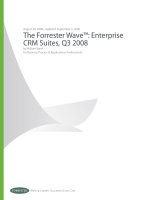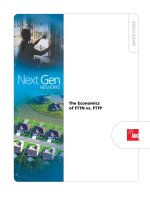Tài liệu The Avidia Advantage Series Subtending: Reduce Equipment Cost and Complexity docx
Bạn đang xem bản rút gọn của tài liệu. Xem và tải ngay bản đầy đủ của tài liệu tại đây (1.03 MB, 8 trang )
white paper
The Avidia Advantage Series
Subtending: Reduce Equipment Cost and Complexity
Executive Summary
In today’s competitive telecommunications environment, you are faced with the challenge of
minimizing the cost and complexity of equipment at the network edge. To meet this need, the ADC
Avidia Integrated Access Switch (IAS) combines the functionality of an ATM edge switch with a
DSLAM. Then, through subtending, in which several systems are viewed and managed by a single
management platform, deployment of Avidia allows you to lower equipment and network
management costs. Avidia concentrates multiple traffic streams to a single network uplink, enabling
the elimination of expensive ATM edge switches. By reducing the number of network elements, you
can reduce the number of element management systems, eliminating associated overhead costs such
as training and staffing. Through subtending, you can lower the cost of delivering high-speed services
to remote customers.
This white paper explores subtending in more detail, by:
• discussing two different configuration types (daisy-chain and star)
• exploring both Central Office (CO) and remote cabinet deployment
• showing the economic benefits that deployment of the ADC Avidia platform provides.
Subtending Overview
Avidia subtending allows multiple systems to be viewed and managed as if they were one system,
through either a star or daisy-chain configuration.
In either implementation, multiple systems connect to one system that aggregates the transmission of
all the attached systems and provides one network uplink. The aggregating system is known as the
subtending or source system and each of the systems connected to it are known as the subtended or
destination systems.
The figure below illustrates example star and daisy chain systems, and are just a few of the many
configurations available through subtending. The subtending systems in each configuration aggregate
the transmissions of the subtended systems and provide a network uplink through OC3 to the ATM
Switch.
Daisy Chain Configuration
Star Configuration
AV3000
AV8000
AV8000
DS1
ATM
Switch
Integrated
Access
Server
Internet
OC3
OC3
OC3
= Subscribers
AV8000
12
PairGain PairGain
AVIDIA3000
AV3000
AV3000
12
PairGain PairGain
AVIDIA3000
AVIDA 2200
AV
54
1
AV
3
5
1
1
2
-A
D
S
L C
E
L
L
12
9
8
5
4
STATUS
1
PORT
FAULT
POWER
AV
6
30
AV
C
C
3A 125V
B
A
PG
air ain
PG
air ain
PG
air ain
Tx
IN
IN
OUT
MON
OUT
RED
AIS
LOS
LPBK
RAI
MON
LINEEQUIPMENT
Rx
SELECT
T1 PORT
ALARM
ACT
MAJOR
MINOR
ACO
T1
CRAFT
TEST
LED
POWER
FAULT
8xT1 IMA-UNI
1
2
3
12
PairGain PairGain
AVIDIA3000
DS1
DS1
DS1
AVIDA 2200
AV
54
1
AV
3
5
1
12
-A
D
S
L
C
E
L
L
12
9
8
5
4
STATUS
1
PORT
FAULT
POWER
AV
6
30
AV
C
C
3A 125V
B
A
PG
air ain
PG
air ain
PG
air ain
Tx
IN
IN
OUT
MON
OUT
RED
AIS
LOS
LPBK
R
AI
MON
LINEEQUIPMENT
Rx
SELECT
T1 PORT
ALARM
ACT
MAJOR
MINOR
ACO
T1
CRAFT
TEST
LED
POWER
FAULT
8xT1 IMA-UNI
1
2
3
DS1
AV2200
AV2200
Subtending With Avidia
Subtending can be set up using any of the four Avidia chassis: AV8000, AV6000, AV3000 and AV2200.
AV8000, AV6000 and AV3000 systems can both subtend and be subtended while the AV2200 is
typically a subtended only system.
The two subtending configurations are explored in detail below.
Subtending Through a Star Configuration
In a star configuration, multiple subtended systems are attached directly to the subtending system that
connects on the edge of the network. The subtending system aggregates the traffic from the subtended
systems, switches all the traffic (its own and that of the subtended systems), and provides the network
uplink.
Each system, whether subtending or subtended, can connect to and manage subscriber traffic through
modem connections.
The following figure shows subtending within a star configuration. This example shows an OC3
interface as the network uplink for the entire subtended system. An AV8000 is the subtending system.
Three chassis are subtended at three separate physical locations (sites). The subtending connection is
through a DS1 link.
Subtended AV2200
Subtended AV3000
ATM
Switch
Integrated
Access
Server
Internet
OC3
Site B
Site C
Site A
= Subscribers
DS1
DS1
12
PairGain PairGain
AVIDIA3000
AVIDA 2200
AV
5
41
AV
35
1
1
2
-A
D
S
L
C
E
L
L
12
9
8
5
4
STATUS
1
PORT
FAULT
POWER
AV
6
3
0
AV
C
C
3A 125V
B
A
PG
air ain
PG
air ain
PG
air ain
Tx
IN
IN
OUT
MON
OUT
RED
AIS
LOS
LPBK
RAI
MON
LINEEQUIPMENT
Rx
SELECT
T1 PORT
ALARM
ACT
MAJOR
MINOR
ACO
T1
CRAFT
TEST
LED
POWER
FAULT
8xT1 IMA-UNI
1
2
3
Subtended AV3000
DS1
12
PairGain PairGain
AVIDIA3000
Subtending AV8000
Subtending Through a Daisy-chain Configuration
A daisy-chain is a serial link (or cascaded link) of up to three systems that has one network uplink
connection and is viewed as one integrated system.
The daisy-chain comprises:
• one system functioning on the edge of the network to aggregate and switch ATM transmissions
and provide the network uplink
• up to two systems functioning as access devices.
Each system, whether subtending or subtended, can connect to and manage subscriber traffic through
modem connections.
The relationship of subtending in a daisy-chain configuration is shown in the following figure. Two cards
per system are needed to connect a daisy chain. Each chassis has one card connecting upstream towards
the network, and a second card connecting downstream to a subtended chassis. This example shows
an OC3 interface as the network uplink for the entire subtended system. An AV8000 is the subtending
system. Two AV8000 chassis are subtended at two separate physical locations (sites). The subtending
connection is through a DS3 link.
When planning a daisy-chain system:
• Plan an alternate or second path (such as a SONET ring) to re-route traffic in case of a failure of
any link in the daisy chain.
• Remember that there is a three system maximum with daisy chaining.
• Consider the maximum distance allowed between systems based on transmission type.
• Remember that you need to provision enough bandwidth upstream and downstream to maintain
Quality of Service (QoS) and overbooking ratios.
DS3
OC3
ATM
Switch
Integrated
Access
Server
Internet
AV8000
Subtended
AV8000
Subtended
AV8000
Network Uplink
DS3
= Subscribers
Benefits of Subtending
Minimize the Expense of Central Office DSL Deployment
As DSL networks are built out to Central Office co-locations, the access network must scale to
accommodate subscriber growth. While single DSLAMs in each CO require only one network pipe for
traffic backhaul, the demands on the network grow as new DSLAMs are added. In order to reduce the
backhaul costs and traffic burdens on the core network over the WAN, you must concentrate uplinks
from DSL traffic as close to the network edge as possible.
Traditionally, this required an ATM edge switch to combine multiple T1s, DS3s, or OC3s into a single
OC3 or DS3 pipe out to the network. This approach was used to minimize backhaul transport costs and
reduce the burden on the overall WAN. An ATM edge switch takes advantage of QoS and traffic
management to ensure network performance is not compromised.
You may only deploy a single DSLAM in each CO when service is first turned up. However, business
models generally anticipate multiple DSLAMs serving more subscribers as you achieve greater market
penetration, as shown in the illustration below.
DSLAM
CO Colocation
DSLAM
DSLAM
DSLAM
Edge
Switch
ATM
OC3
OC3
OC3
OC3
Core
Switch
OC3
Internet
OC3
NOC
OC12
BRAS









